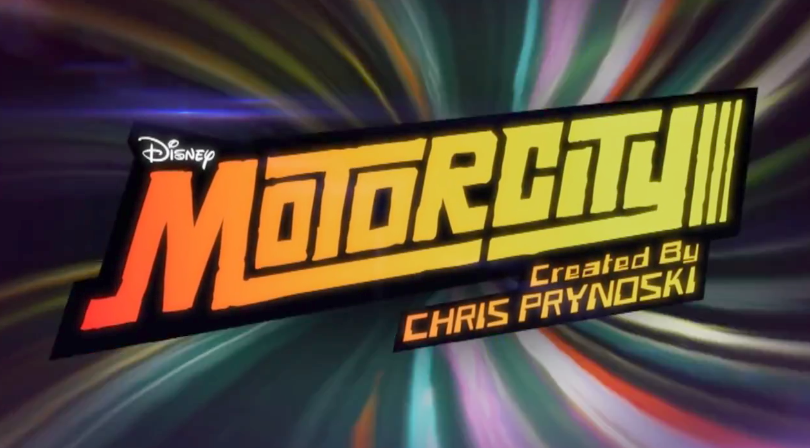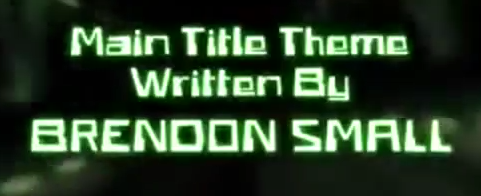While watching Disney’s 2012 Motorcity, I was immediately stuck by the show’s theme. Heavy on the aggressive drums and angry electric guitar, I wondered out loud, “Damn, it’s as if Deathklok themselves were scoring this show.” And sure enough:
Brandon Small, if you weren’t aware, also produced Metalocalypse, the Adult Swim show starting the infamous fictional metal band Deathklok, a bunch of goth-driven meatheads with amazing musical talents and even more amazing mystical abilities. Deathklok is loved by millions, even as their heavy metal melodies and viciously ludicrous stage shows kills thousands of people. To fans of that type of music, Deathklok is a genuine cult favorite, which the fake band’s music filling the playlists of many people. To non-fans, it’s a different story. Heavy metal is not a genre for everyone, and it must be acknowledged that it’s a type of music that is inherently alienating. To be clear, a lot of music is, but when you lean on that music as a premise and a narrative device, it becomes important to push the characters and story beyond that; otherwise, you’re essentially admitting that this show is only for a select crowd. There’s making entertainment for a niche audience, and there’s making entertainment for an exclusive audience. Metalocalypse, an 11-minute show on a channel defined by niche, could get away with it. Motorcity, on a heavily watched network driven by appealing to as broad an audience as possible, could not.
There’s a lot wrong with Motorcity at the premise/narrative/character level, and I’ll get into that, but most of those problems are triggered right at the start with the very inherent aesthetic thrust of the show. Motorcity has no qualms about its mission: to be relentless. It gives one hundred percent into its visual acumen, making racing, action, and high-octane excitement its fundamental purpose of existence. Every single thing on the show is defined by speed and power; it is the blood of a million Poochies surging together at once, high on cocaine and masturbating to the final act of the Wachowskis’ Speed Racer. Right at the start, Motorcity draws its line in the sand, declaring itself exclusive entertainment – strictly in the imaginative realm of young, white, 7-11 year-old boys. (Not to say that there isn’t a subset of girls or non-white kids who wouldn’t like it, but by the nature of our cultural signifiers, it’s clear that the show had one primary demo in mind.)
Motorcity is careless about its carelessness. It’s knows exactly what it wants to be, but it commits to doing just that with a shocking lack of insight or inclusivity. How could I make such a claim? Well, let’s consider that the show takes place in Detroit – a city that’s been going through a social/financial crisis for the last twenty-five years. Even as the show was pitched to Disney (which, considering the development process of cartoons, had to have been somewhere between 2007-2009), Detroit was struggling with its debts and crime rate, its unemployment and its reputation. And to be fair, there is a certain bold vision in taking that massive, systemic brokenness and re-contextualizing it as a tale of two worlds – the glorious, cultish, oppressive perfection of Detroit Deluxe, and the messy, chaotic, tumultuous environment of Detroit. But Detroit is a real city, with real problems, and there’s a certain callousness in taking that and marketing it as a world yearning to race freely in order to sell new Hot Wheel miniatures.
Motorcity cares so little for the real Detroit (imagine living in actual Detroit and watching this show), but cares even less about the people who live in their fictional Motor City. It’s actually surprising, almost absurdly offensive, how indifferent the show is to anyone outside of the Burners – the main group of five age-indeterminate characters tasked with protecting Detroit from Kane, the leader-tyrant of Detroit Deluxe. Certainly Motorcity has no obligation to explore the struggles of real-world Detroit and its people in any way, but it certainly should have explored its own duel-Detroit conception, and asked, exactly, what are the pros and cons of each version of Detroit, and how the citizenry is thriving or struggling within it. (For all its faults, Project GEEKER handled that pretty well.)
Not only does the show fail to engage in its own world-buidling, the ways in which it fails to do so are baffling. Nothing exemplifies this like “Vendetta,” an episode that is supposed to give history and nuance to Burner leader Mike Chilton, but instead turns the people of Detroit into utter useless zombies. Mike, who formally worked for Kane, was assigned to destroy a building in Detroit. On the eve of the destruction, Mike just notices that there are actual citizens still living in the building. The episode tries to play this as a crisis of conscious for Mike – the up-and-coming young soldier who has to question his morals and the various lines he’d have to cross towards his career – but the actual scene comes off completely tasteless. The people inside the building just sit there, staring wide-eyed like helpless animals. There’s not a single sense of civic protestation or argument. The people don’t even bother to flee the building until Mike has his change of heart and heroically leads the people out of the demolished building, the young Pied Piper leading the hive-minded rats out of the destroyed complex. There’s a million ways this scene could have played out (if the people were all asleep, for example: it still has issues, but at the very least the idea of taking them surprise provides a tighter context for lack of civil action). Motorcity opts for a lazy out, an out that suggests the people of Detroit (and Detroit Deluxe, for that matter) are useless sheep, inherently broken and useless unless a (white, male) leader guides them to their perceived safety.
And that’s just fucking gross.
Yet it’s the shockingly core thrust of the show’s entire run. The surface-level appeal, with its charismatic cast, seemingly complex structure, and violently intense animation, does its best mask a show so hollow that it defies expectation. Motorcity practically goes out of its way to make it less interesting than it should be, and when it finds itself in a narrative hole, it literally bullshits its way to a conclusion. After twenty episodes, I have no idea how Julie’s holographic powers work. I’m not clear if she’s actually in Detroit Deluxe or Motorcity and simply is projecting her holographic self elsewhere. Another example: the pilot suggests large scale gates block Kane’s infinite supplies of robots from entering regular Detroit; in subsequent episodes, robots come and go as they please. Even the action scenes – the very thing that Motorcity was noted for (and the very reason Titmouse was chosen to animate Turbo FAST), are purposely chaotic to hide their sheer lack of logic. The racing and fight scenes are structured in a hyper-energetic, anime-driven way, but (in what may be the most ironic thing of all of 2012) the animation is too good for it. Millions of lasers and explosions that constantly miss the protagonists only serve to lower their stakes. The few times where danger seems inevitable, the solution is either: 1) make it bigger, 2) make it faster, 3) stall until you can make it bigger or faster. When that doesn’t work? Throw lights and colors at the screen as a distraction, then say they won. Or hell, just ignore it completely. “The Duke of Detroit Presents…” straight-up insults its viewers when it places the Burners in a literal “can’t escape” situation and cuts to them later on, all alive and well. There’s a “jokey” reason for this, but it fails mainly because it’s representative of a show that attempted to slickly cut corners when it needed to drive straight.
And that may be the answer in the end: Motorcity is a joke, a flaccid excuse for a visionary animation reel, not a premise for a viable show. The penultimate episode, “Threat Level: Texas!” is an admission of sorts, retelling the previous episodes as viewed through the comic perspective of Texas, a character whose comic relief persona is not only unfunny but borderline sexist (he keeps confusing Julie’s name). None of the other characters mattered much more, really: Dutch just wants to paint and Chuck is a wussy hacker who doesn’t even know how to drive (his desire to keep that a secret is remarkable dangerous). That just leaves Mike, who is a borderline Mary Sue, and whose personal stakes fluctuate with each episode. But he’s there as the teenage icon upon which that remarkably narrow demo of white young boys would cling to, a demo predicted to be satisfied with speed, action, movements, and racing. Motorcity does little to give any incentive to court viewers outside that demographic, embracing its exclusivity with an uncomfortable, misguided sense of aplomb, but no amount of action intensity could overcome the changing demographic yearning for inclusivity. Motorcity courted its specific audience with as much high-octane hoopla as possible but only succeed in driving itself into the ground.




#1 by Malcolm on September 4, 2015 - 11:15 pm
Hmm…while it was interesting to read another view on why this show got cancelled, I feel this article comes off as more persnickety than most of stuff on this site.
I feel it would have been better to give your thesis, but also mention what the creators were trying to do with the show:
http://geek-news.mtv.com/2012/05/18/motorcity-creator-chris-prynoski/
BTW, because you called Moke Chilton white, I’m posting these:
http://peopleofmotorcity.tumblr.com/post/29134551478/i-heard-from-someone-that-mike-is-a-poc-do-you
http://peopleofmotorcity.tumblr.com/post/24089273020/darqv-almost-nobody-realizes-that-texas-is
#2 by Admin on September 5, 2015 - 10:40 am
Hi Malcolm,
I’m certainly fine with disagreements, I would imagine that there are plenty of fans that were disappointed to see the show go. I’m a bit confused why you call it persnickety, though.
Anyway, thanks for the links. It’s interesting to see Chris’s personal take, which is indeed present in the show, although it does confirm that he’s primarily interested in car culture and, oddly enough, Texas, instead of the actual world he created – he hardly mentions anything about it. As for Mike being white – I could remove that parenthetical and the essence of the problem would still be the same. I guess I just would’ve like to see the people of Detroit have some kind of personal agency outside of Mike.